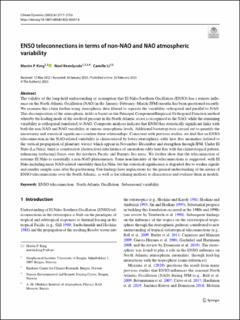| dc.contributor.author | King, Martin Peter | |
| dc.contributor.author | Keenlyside, Noel Sebastian | |
| dc.contributor.author | Li, Camille | |
| dc.date.accessioned | 2023-12-21T14:06:21Z | |
| dc.date.available | 2023-12-21T14:06:21Z | |
| dc.date.created | 2023-03-07T13:55:11Z | |
| dc.date.issued | 2023 | |
| dc.identifier.issn | 0930-7575 | |
| dc.identifier.uri | https://hdl.handle.net/11250/3108657 | |
| dc.description.abstract | The validity of the long-held understanding or assumption that El Niño-Southern Oscillation (ENSO) has a remote influence on the North Atlantic Oscillation (NAO) in the January–February–March (JFM) months has been questioned recently. We examine this claim further using atmospheric data filtered to separate the variability orthogonal and parallel to NAO. This decomposition of the atmospheric fields is based on the Principal Component/Empirical Orthogonal Function method whereby the leading mode of the sea-level pressure in the North Atlantic sector is recognised as the NAO, while the remaining variability is orthogonal (unrelated) to NAO. Composite analyses indicate that ENSO has statistically significant links with both the non-NAO and NAO variability at various atmospheric levels. Additional bootstrap tests carried out to quantify the uncertainty and statistical significance confirm these relationships. Consistent with previous studies, we find that an ENSO teleconnection in the NAO-related variability is characterised by lower-stratospheric eddy heat flux anomalies (related to the vertical propagation of planetary waves) which appear in November–December and strengthen through JFM. Under El Niño (La Niña), there is constructive (destructive) interference of anomalous eddy heat flux with the climatological pattern, enhancing (reducing) fluxes over the northern Pacific and Barents Sea areas. We further show that the teleconnection of extreme El Niño is essentially a non-NAO phenomenon. Some non-linearity of the teleconnections is suggested, with El Niño including more NAO-related variability than La Niña, but the statistical significance is degraded due to weaker signals and smaller sample sizes after the partitioning. Our findings have implications for the general understanding of the nature of ENSO teleconnections over the North Atlantic, as well as for refining methods to characterise and evaluate them in models. | en_US |
| dc.language.iso | eng | en_US |
| dc.publisher | Springer | en_US |
| dc.rights | Navngivelse 4.0 Internasjonal | * |
| dc.rights.uri | http://creativecommons.org/licenses/by/4.0/deed.no | * |
| dc.title | ENSO teleconnections in terms of non-NAO and NAO atmospheric variability | en_US |
| dc.type | Journal article | en_US |
| dc.type | Peer reviewed | en_US |
| dc.description.version | publishedVersion | en_US |
| dc.rights.holder | Copyright 2023 the authors | en_US |
| cristin.ispublished | true | |
| cristin.fulltext | original | |
| cristin.qualitycode | 2 | |
| dc.identifier.doi | 10.1007/s00382-023-06697-8 | |
| dc.identifier.cristin | 2131983 | |
| dc.source.journal | Climate Dynamics | en_US |
| dc.source.pagenumber | 2717–2733 | en_US |
| dc.identifier.citation | Climate Dynamics. 2023, 61, 2717–2733. | en_US |
| dc.source.volume | 61 | en_US |

